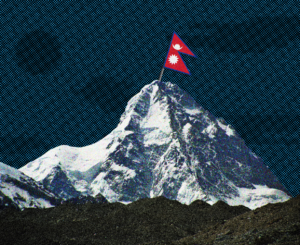There are moments when your life depends on a single foot. As I traverse the snowy upper slopes of Colorado’s Mount Harvard at 14,400 feet in elevation, the stakes are high. One misstep here and I could conceivably fall hundreds of feet down an icy cliff. There are no ropes and no second chances. My head spins and my sight begins to blur. I have never been this afraid in my entire life. I have also never felt more alive. I ask myself the same question every time I climb, “Why on earth do I do this?”
I have been addicted to the mountains my entire life. My parents had me hiking as soon as I could walk; even before that, my father would carry me up the mountains on his back. The same is true for the rest of my family. Even though we’re spread out all over the world, the one thing we all have in common is a fondness for the high peaks. In my adoration of the mountains, I assume that my love is requited. It is easy to imagine the mountains alive as the alpine gods and goddesses of folklore, smiling down at you with their magnificent cliff faces. It is only when the rock gives way, your fingers stiffen with frostbite, or the thunderstorms roll in and you are forced to run for your life that you realize the mountains are not living, benevolent beings. They are rock, ice, and vegetation, and they will not spare you from their dangers.
Instead, they are sirens. Their songs of liberation and beauty are hard to ignore, easy to be enthralled by and, sometimes, fatal. It is virtually impossible to make the mountains a large part of your life and not know someone who has lost theirs to them.
My family is no exception. For us, the mountains have meant death as much as life. When my uncle Michael was 19 years old—my current age—he went climbing in the Peruvian Andes. The day his climbing group set off on their summit attempt, he remained at camp with one of his team members who was sick from the altitude. The next day, they left with their ice picks, helmets, and gear in their own summit attempt. They never returned. The bodies of Michael and his climbing partner were discovered hundreds of feet below with their axes still clinging onto the ice above.
I never met Michael, but his story—and our uncanny similarities—haunts me. Photographs show a physical resemblance between us. Family members are quick to point out our shared mannerisms. We were both considered to be the “smart” ones of the family. At the time of his death, he was also a first year student in university with a bright future. Like me, there was nothing that made him feel more alive than being in the mountains. Hunkering on the ice over 14,000 feet, I can’t help but wonder if I might end up like Michael. If one day, my love of adrenaline will catch up with me and I will get too close to the brink and cross over that hidden line.
Everyone starts off a climb with the same goals—to have fun and to get home alive. But by the time you are even ten steps in, those goals get skewed. Your entire world refocuses onto one thing—the summit. The closer you get to the top, the more painful it is to turn around. The more addicted you become to the mountains, the more invincible you feel. It is both a glorious and horrible mentality to adopt. When the lightning storms form out of nowhere or a section of precarious rock shifts under your feet, you have to make the agonizing choice to protect yourself or take a chance for the summit. For me, it is the hardest choice in the world.
Before he lost his life climbing Mount Everest in 1924, a reporter asked mountaineer George Mallory why he wanted to climb the perilous mountain. “Because it’s there,” he replied in frustration. His answer makes perfect sense to me. I see a towering column of rock and I just have to climb it. Call it a sense of adventure, or pride, or sheer stupidity. There is something breathtaking about standing at the highest point observable, walking somewhere few have been before, and being immersed in an awe-inspiring panorama. Even on days with horrible weather and slick rock, there is undeniable pride that comes with battling the elements. There is something attractive in the gnarliest of mountains that bring a greater sense of achievement and glory when you reach the summit with a little skin in the game. There is no feeling more alive than knowing that any moment, in the unpredictability and ever-changing wildness of the mountains, you could die.
It is this mentality that makes me feel most connected to Michael. I do not blame Michael for his death; I understand it. I know that if I were in his position, I would probably have made the same decision to climb on, even if it cost everything.
But being alive is critical to feeling alive. I think that mountaineers have a poor habit of becoming Icaruses. We push the limit, climbing higher and higher, until we eventually reach that unforeseen edge. Too quickly, addiction to the mountains can become a fatal flaw. To choose the summit over safety is also something I recognize as horribly selfish. The last thing I want to do is become injured, or worse, perish in the mountains. After Michael’s death, I know it would hurt my family beyond belief to lose another person to them. I also remember the other goals to live for besides the summit. School, work, friendships, and my future are worth turning back for. I can return to climb another day.
It doesn’t have to be a choice between a life without danger or a life without thrill. I have been told that I am reckless, that I have a death wish, but it is simply not true. For one thing, while the stakes are high, the chance of being hurt is relatively low. I have experience in the mountains, the correct gear, and am not reckless. So while the environment around me might be inherently risky, life-threatening danger is not something I actively pursue.
When you stand above 14,000 feet into the earth’s atmosphere, your entire perspective of the world changes. There is forty percent less oxygen than at sea level. My head becomes dizzy, stomach nauseous, and mental facilities reduced. Looking at the surrounding peaks around me, I notice the tracks of fresh avalanches. I look down at two eagles soaring in the open space below. For one moment, I feel like the most miniscule part of the universe and there is something immensely humbling about it. The rest of the world of work, responsibility, and relationships is literally miles away. I feel like an outside observer to the universe and for one fleeting moment, I feel perfect. And it can be gloriously addicting to feel perfect.
I believe that there is little point in living if your life is devoid of any risk factor. It is when your heart is beating and you feel something, even if that something is terror, that you truly know you are alive. You do not have to be an adrenaline junkie or pursue life-threatening activities to recognize this feeling. The risks we take in life vary by person. For some, it is speaking up in a crowd, telling someone you love them, or leaving home to study at a university across the world. All these acts can offer you immense joy, but only if you are willing to accept the risk.
Like the way I balance my spikes in the snow of Mount Harvard’s summit ridge, I must learn to balance my hunger for adrenaline with the acceptance that I have a life beyond the mountain. It isn’t easy. Similar to the tightrope of ice I traverse, this line is almost imperceptible. It is still a conscious choice, between turning around and maximizing my chance to enjoy the rest of my life or partaking in the risk. But cautious step by step, I find myself on the summit. A perfect equilibrium of rock, ice, and gravity. The crux of the mountain, my meaning, and Michael’s memory.





